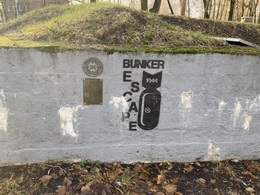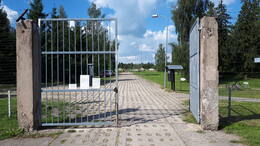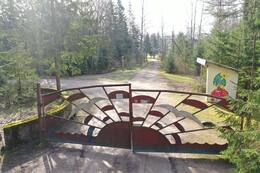Military heritage along the Iron Curtain
Day 2.
90 km
Klaipeda - Kretinga - Salantai - Plateli
Practical info
- The itinerary is intended as a guide - how to optimally travel a region or country, or two countries, with the aim of getting to know their military heritage;
- The driver must plan for himself - how many of the recommended objects and places he can explore in one day;
- Before traveling, you should check the opening hours of sightseeing places (museums, collections, fortifications, etc.);
- For places where advance booking is required (local guides, private collections, etc.), a visit must be booked, specifying the date and time. If the trip is cancelled, the places booked must be informed;
- Accommodation must be booked in advance. Accommodation may be unavailable during the summer season, especially on the coast. Some catering establishments may not be open during the winter season;
- Choose not only summer for your trip, but also other seasons;
- The Latvian-Lithuanian-Estonian borders can be crossed by road freely without restrictions and at any time of the day. When entering from one country to another, you must have an ID card or passport with you;
- Visit tourist information centers where you can get additional information, brochures, and maps.
Sights
“Escape bunker 1944”
“Escape bunker 1944” is located in the city centre of Klaipėda.
It is a German Army tunnel shelter built in 1944 to help the civilian population of Klaipėda survive the bombing and artillery shelling of World War II. This shelter is believed tohave been built by the Railway Administration of the Reich. The bunker is made of one-metre-thick reinforced concrete walls with an earth embankment on top.
Since 2009, the shelter has been included in the Register of Immovable Cultural Property of the Republic of Lithuania, and the site has been marked with a military heritage label. Long neglected, it was restored in 2016 pursuant to a private initiative. It is now an escape room, a room for solving puzzles, which, consequently, prevents the shelter from deteriorating while creating entertainment for the residents.
Orvidai Homestead-Museum
The Orvidai Homestead-Museum is located near Salantai, on the right side of the road Salantai-Plungė (KK169) (there are information signs).
The site was started more than 40 years ago by a family ofstone cutters – a father and son – Kazimieras and Vilius Orvidai (1905–1989; 1952–1992). During the land improvement works, they brought interesting-looking stones scheduled for crushing and centuries-old trees from the surrounding fields to their homestead and used them to create religious monuments. The works created by the Orvidai themselves at their farm homestead, as well as works by other artists displayed there did not conform to Soviet ideological and artistic canons: the works made of stone, wood, metal and old agricultural tools intertwined the symbolism of different religions (Catholic, Pagan, Buddhist). The homestead was also well known to those who did not fit into the reality of Soviet life. The place became a site of refuge and gathering for those who thought differently. The Soviet power repeatedly planned to destroy this environment, however, people managed to preserve it. The Orvidai homestead became very popular during the Lithuanian revival.
An IS-2 tank welcomes visitors at the Orvidai Homestead-Museum. This tank was developed by the Soviet Union during World War II as a response to the German Tiger I. The name IS is an acronym for the Soviet tyrant Joseph Stalin. This tank was formerly located in Salantai as part of the Memorial dedicated to the World War II Soviet burial. In 1991, it was relocated to the Orvidai homestead and became an exhibit.
Litvak Memorial Garden
In 2014, the Jacob Bunka Charity and Support Foundation established the Litvak (Lithuanian Jew) Memorial Garden in Žemaitija National Park, approximately two kilometres from the centre of Plateliai, in the village of Medsėdžiai. It is a monument dedicated to the eliminated Jewish communities of Lithuania. The garden reproduces the contours of Lithuania, while the sites where Jewish communities were eliminated in 1941–1944 are marked with wrought-iron apple trees. The author of the carved apple trees is Artūras Platakis. The apples in the trees signify families that have lived in these communities. Litvaks from around the globe can participate in the development of the garden by ordering new apple trees and apples in memory of their ancestors. The garden also features pillars made of Karelian granite that individually celebrate the achievements of Litvaks worldwide.
In 2016, the initiative was extended to include the Litvaks, who lived throughout the territory of the Grand Duchy of Lithuania, and the rescuers of Jews during the Holocaust. A billboard at the entrance to the garden tells the story of former Jewish communities throughout Lithuania.
Currently, apple trees to commemorate the Jewish communities of Alytus, Alsėdžiai, Kalvarija, Mosėdis, Plateliai, Plungė, Telšiai, Vabalninkas, Viekšniai, and others have “grown” at the garden.
Cold War Exposition
On 31 December 1962, one of the first underground launch complexes for R-12 ballistic missiles in the Soviet Union, the Dvina underground launch complex, was put into operation
in Plokštinė Forest (Plungė district).
Between 1963 and 1978, four R12 medium-range ballistic missiles (SS-4 Sandal) equipped with a 2.3-megatonne nuclear warhead were deployed at the complex. All the missiles were aimed at Western European countries. This complex, together with similar surface-launched missile bases, formed a single Soviet nuclear arsenal in Lithuania, which was capable of destroying the whole of Europe. In its 16 years of operation, not a single missile was fired, despite the declaration of combat readiness during the Prague Spring in 1968.
After the Soviet soldiers left on 18 June 1978, the poorly guarded military facility was vandalised and looted. In 1993, when the complex was handed over to the Žemaitija National Park Directorate, its restoration began. In 2012, the Cold War exposition was opened. Today, this once very secret and guarded place is open to the public. A historical exposition on the Cold War period is on display at the former missile and equipment control room house. To date, it is the only museum in urope where a preserved underground missile launch silo is on display.
Plokštinė Military Town
In 1962, one of the first underground launch complexes for R-12 ballistic missiles in the Soviet Union, the Dvina, was put into operation in Plokštinė Forest (Plungė district).
A military camp was set up 0.5 km from the missile launch site. It occupied an area of 12 hectares, and approximately 30 buildings were built here for various purposes, including residential houses (barracks), officers’ headquarters, two canteens, a boiler house, a power station, a medical post, a club, a pig farm, warehouses, garages, and other structures.
The Plokštinė underground missile launching complex was operational until 18 June 1978. The Soviet soldiers left the area, taking only their weapons with them. In 1979, the management of the former military complex was transferred to the Republican Association of Agricultural Recreation Facilities of Plungė District, and the Plateliai Pioneer Recreation Camp “Žuvėdra” was established at the military campus site. The site was reconstructed and adapted to the needs of the camp, which operated until 1990. After the restoration of Lithuanian independence, the Pioneer Camp was closed.
Since 1993, the site has been managed by the Žemaitija National Park Directorate. In 2017, many of the structures on the military campus were demolished due to their state of disrepair. Today, there are about ten buildings left at the site, and visitors may see them from the outside. Information boards about the former buildings and their functions have been installed.
Places to eat
LINELIS
- In Klaipeda, see. clipdatatravel.lt
- In Cretting, cf. visitcrate.lt
- Cafe “Pakalnutė”, Salantai
- Café “Le le terrace”, Paejer to Rudaichia
- Café “Burė”, Plateliai (open in summer season)
- In the plunge, see. visitplunge.lt
- "Smagratis Restobar", Crate
Places to stay
- In Kretinga, see visitkretinga.lt
- Plates zemaitijosnp.lt
- In Plunge, see visitplunge.lt









